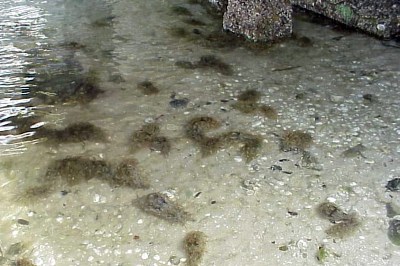
Mass mortality
PHOTO
Mass mortality of Bursatella leachi, Florida, Gulf of Mexico, February 2001. Photo: Dana Mueller.
At times, large numbers of Sea Slugs, usually Sea Hares, are found dead and dying in large numbers, often in the shallow intertidal. While it is possible this phenomenon could be the result of pollution, it is more likely that natural causes are the cause.
Sea Hares are often found aggregated in large numbers, often stranded and dying at low tide. Have a look at the message about the small Sea Hare Stylocheilus striatus, where I discuss some of the ideas we have about these mass deaths in Sea Hares. Basically it seems that sometimes, when conditions are very favourable, large numbers of juveniles settle out of the plankton and grow rapidly to maturity (a bit like the 'baby boomer' generation after the Second World War). However at the inevitable dying end of the life cycle they all tend to die at the same time. This does not mean to say that there are not outside events which hasten the end. If these large populations coincide with periods of hot weather, relatively warm water and very low tides, death of intertidal animals, especially on broad sandflats, is often inevitable. At low tide exposed animals can be overheated and desiccated, and the returning sea water as the tide turns, rather then providing relief, brings water which has been heated and deoxgenated as it runs in over hot sandflats. Alternatively a period of rough weather and storms can dislodge and wash large numbers on to the shore. In these cases I am afraid there is nothing much we can do. It is an unusual but natural phenomenon. For more general information on Sea Hares have look at the list of 'Sea Hare' topics in the GENERAL TOPICS index.
See messages and discussion below.
See also the following messages elswhere in the Forum:
• Sea Hare mating chains
•on Mass mortality in Aplysia californica in Baja California.
•on Population Fluctuations.
•on Mass mortality of Aplysia dactylomela in Florida.
•on Adult dispersal in Stylocheilus striatus in Hawaii
•on Swarming in Stylocheilus striatus in Hawaii (1).
•on Swarming in Stylocheilus striatus in Hawaii (2).
•on Swarming in Stylocheilus striatus in Hawaii (3).
•on Swarming in Stylocheilus striatus in Caribbean.
•on Swarming in Stylocheilus striatus in Turks & Caicos Ids
•on Swarming in Stylocheilus striatus in Barbados
•on Mass mortality in Aplysia brasiliana.
•on swarming in Aplysia fasciata.
•on swarming in Aplysia gigantea.
•many messages in February - March 2001 on Mass mortality in Aplysia morio in Florida.
•4 messages on Mass mortality in Bursatella leachi in Auckland, New Zealand, May 2000.
•3 messages on Mass mortality in Bursatella leachi in Florida.
• Breeding aggregation of Bursatella leachi in Trinidad, West Indies.
•message on egg laying and Mass mortality in Bulla quoyii in New Zealand.
Rudman, W.B., 2001 (March 22) Mass mortality. [In] Sea Slug Forum. Australian Museum, Sydney. Available from http://www.seaslugforum.net/find/massmort
Related messages
Stranding of Sea Hares in New South Wales
July 2, 2007
From: Brenda Harris
Dear Bill,
About three or four months ago after a few days of extremely high tides and rough water, I was walking the dog as I usually do along the waterfront at Davistown, a suburb of Gosford, 80 km north of Sydney, and noticed a few round things on the sand. I thought they were blown dead fish as sometimes happens but as I walked further along there were 30 or 40 of them all along a stretch of sand approx 200 metres long. There were more scattered further along up to probably a kilometre but the main concentration was in the one 200 metre area. I thought they were sea slugs but having searched the internet and found your site they are definitely sea hares.
I have been walking dogs down there for 13 years and have never seen them there before and have been talking to people who have lived there for 40 years and have never seen them there before. I walked along pushing them all back into the water. Since then the main concentration in the 200 metre stretch have been out every day I am down there at low tide - usually around 30 of them. I always throw them all back into the water. However I always walk the dog at the same time every day so it is not always low tide. This area is one of the more populous areas for people to walk along the waterfront and there is a ferry stop and jetty close by so the ferry makes fairly large waves when it comes in to stop.
The area of water is a wide channel, and across the channel from Davistown is Empire Bay. Would these sea hares have been washed in to the channel with the high tides? We have high tides every full moon but they haven't been in before. Are they choosing to come out on to the beach, or are they being washed up there and are unable to get back into the water? Am I injuring them by throwing them back out? They will only dry out if they are left there, - or will they find their own way back to the water if it becomes too hot? I am not down at the waterfront throwing them back in for 3 days out of 8. How do they survive on those days? How long can they live out of water assuming they are in the shade (which they're not) ? As they seem to be washed up every day, should I be gathering them up in a bucket and taking them to another area of the waterfront where the ferry is much further out and is not so populated with small boats and people? There is a 3 foot high honeycomb concrete block retaining wall separating the grassed area from the sand. Sometimes some of the sea hares have their heads buried in the tiny holes in the wall but their bodies are still very exposed to the sun. I try to prise these ones out so that I can throw them back in to the water. They come in all shapes and sizes, from approx 7 cm long to approx 25 cm long.
A few weeks ago there were approx 20 very small ones. They could bury themselves entirely in the holes in the besser block. Would they have come in originally to mate? Wouldn't they have done this in other years if that's the case? Since the wild storms we had 2 weeks ago I have not seen any of them - until a few days ago. I don't know whether they have been washed back out 'from whence they came', dashed against the besser block wall and killed, or washed over the wall and are buried, rotting, under the huge piles of seaweed that was washed over the wall. A few days ago I saw one of the regulars, a big fellow approx 25 cm long and approx 12 cm wide. It is always by itself 500 metres down from the main concentration, This is always the first one I come across on my walk and it is not always there - only every 3 or 4 days, but it is on a large area of exposed sand at low tide. I threw it back into the water as I always do. It was the first and only one I had seen since the storms. It was there again yesterday in a puddle of water about twice it's size. As it was an overcast day and it was in a puddle, my husband and I discussed it and decided it should be ok there and to leave it there rather than distress it by throwing it back. I went past today and it was dead in the same puddle we had left it in. What a waste - we had been right there! Also today there were 3 out on the sand a considerable way further along than they have been before. Maybe they have been washed further down. I am very much of the opinion that we as human beings have a brain and we have the dexterity and means - in many cases it is very easy for us to save stranded or injured wildlife. I'm walking down there most days - it doesn't take very much to throw 30 of them back in the water, although the dog gets somewhat impatient ! But I don't want to be doing the wrong thing. I don't want to be throwing them back in the water if they've just spent the last 2 hours slowly crawling out on to the sand, or if it is injuring them by doing so. I feel that if they are being washed up onto the sand in the same place every day, then surely the intelligent thing to do is to move them somewhere where they're not going to be washed up every day. But where is the right spot to move them? And are they being washed up or are they choosing to be there?
My apologies for such a long email. I hope you can find the time to answer my multitude of questions as I would really like to help the sea hares, but do not want to end up only hindering or injuring due to ignorance.
Thank you very much for your time.
Brenda Harris
derek@dentran.com.au
Harris, B., 2007 (Jul 2) Stranding of Sea Hares in New South Wales. [Message in] Sea Slug Forum. Australian Museum, Sydney. Available from http://www.seaslugforum.net/find/20081Dear Brenda,
I have a page on the Forum on mass mortalities which covers the phenomenon you have been experiencing. Essentially sea hares only last about a year and sometimes they spend their whole lifecycle unnoticed and other times some natural event gives them a nudge to a slightly early death - which often results in these mass strandings. Unfortunately there is not much you can do to help. Even putting them back in the water only delays the inevitable by a day or so as they get washed ashore again and stranded by another tide .. but I can understand you distress and concern.
Have a look at a recent message from northern NSW [#19452]. If you follow some of the correspondence back and look at the links to other species all around the world you will see that your thoughts and endeavours to save them are fairly universal. You are lucky however that you don't live in Western Australia. The large species, Aplysia gigantea, which washes ashore there often causes severe or fatal poisoning in dogs [see messages attached to that Fact Sheet].
Best wishes,
BillRudman
Mass Stranding of Sea Hares in nthn New South Wales
February 14, 2007
From: Belinda Allman
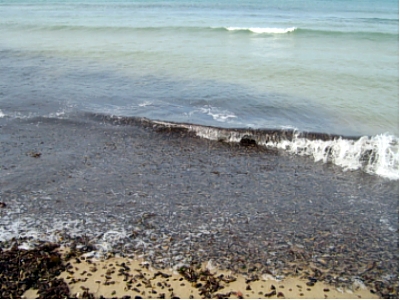
Dear Bill,
Over the past month your Sea Slug Forum has been a great reference to our organisation, most especially to me. Although my expertise lay in other areas of natural resource management, my general knowledge of coastal marine ecosystem was called on during the past holiday period at Killick Beach and Killick Creek estuary [Crescent Head, northern New South Wales, Australia] to monitor red macroalgae blooms and sea hare strandings for Kempsey Shire Council and DPI fisheries. In total there were two strandings at Crescent Head and one at Point Plomer, 14 km south of Crescent Head.
In the first stranding, [4 January, 2007], tens of thousands of sea hares stranded on the spring tide, probably pushed ashore by moderate prevailing north east onshore winds, along the ocean shore of Killick Beach and Killick Creek. There was a second stranding on 14 January. Although this event was not as large, more varied marine algae species were involved and there seemed to be two species of sea hares. I have attached photos of the dominant species, which was also the species found in the first stranding. The other species, which I haven't photos of, was lighter and smaller.
Between Christmas and New Year this region often experiences a few days of cooler intertidal ocean temperatures. This year the low temperatures lasted almost a month and were experienced much further down the coast. I am no expect in this field but I cannot help but feel that the turbulent currents that dislodged the sea hares (and marine algal also) had something to do with the upwelling of cold ocean waters, the edge of the continental shelf being very close at this part of the coast. However, I am of the assumption we probably will never know the reason for these events.
I am just preparing a report on the strandings. The Sea Slug Forum has provided me with all the background info I require, however a positive I.D of the most dominant species would be valuable. Again, thank you for your interest and support with the sea hares stranding. It has definitely inspired me.
Kind regards,
Belinda Allman B.App.Sc.
Acid Sulfate Soils Project Officer
Kempsey Shire Council
Belinda.Allman@kempsey.nsw.gov.au
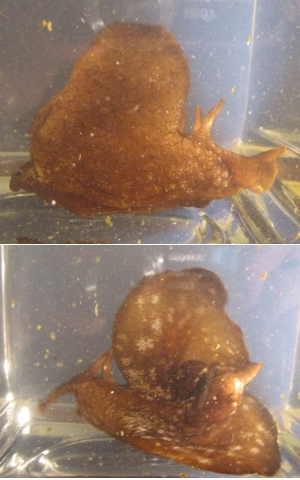
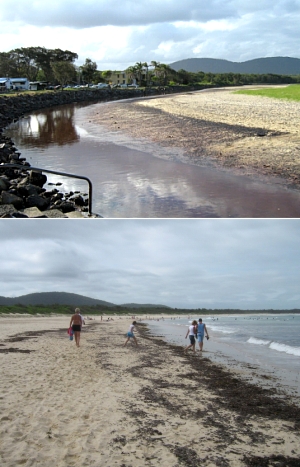
Dear Belinda,
I am glad the Forum could be of help. As two earlier messages on the Crescent Hd strandings demonstrate, [messages #19232, #19225], these mass mortalities do alarm members of the public, and the smell of dead animals and the fear of environmental catastrophe can upset the relaxing effect of a summer holiday at the beach. The species of Sea Hare you have sent photos of is Aplysia extraordinaria which can grow even longer than the 11 cm of your largest. It's possible a second species was present as well, but it could have been one of about three species.
PHOTOS: Upper right: sea hares stranded on ocean beach - 14 January 2007. Lower left: living sea hare - 11 cm long. Lower right: Upper photo showing stranded animals which had been washed far up the creek at high tide and stranded as the tide receded - 4 January 2007. Lower photo showing sea hares stranded along the ocean beach after second and smaller stranding of 14 January. Photos: Belinda Allman.
Thanks for keeping us informed
Best wishes,
Bill Rudman
Re: Mass Stranding of Sea Hares in nthn New South Wales
January 16, 2007
From: Inger Vandyke

Concerning message #19225:
Hi there,
I am another witness of the Crescent Head sea hare stranding and returned from that location last night (14 January). All facts from the previous post were as I had witnessed also except we noticed there were some individuals that were slightly different than others in that they had white spots. This didn't appear to be size related.
Locality: Crescent Head, up to 3 m, New South Wales, Australia, On shore location, calm water conditions, 14 January 2007, Intertidal, sandy bottom. Length: smallest 20 mm largest around 240 mm. Photographer: Inger Vandyke.
I also wondered, since I am a keen diver, if the unsettled water temperatures from the last six weeks may have had something to do with this. I dive two weeks before Christmas in 23 degree C water temperature. The following week in the same location was 16 degrees. I didn't record this at Crescent Head I'm sorry.
Is there a connection between sea hare reproduction and water temperature?
Thank you for a great site. You have solved the ID query I have had for years looking at large sea hares in Nelson Bay, NSW.
Regards
Inger Vandyke
ingervandyke@hotmail.com
Inger Vandyke, 2007 (Jan 16) Re: Mass Stranding of Sea Hares in nthn New South Wales. [Message in] Sea Slug Forum. Australian Museum, Sydney. Available from http://www.seaslugforum.net/find/19232
Dear Inger,
Thanks for the photos. It's possible that water temp has something to do with it but these animals are living off shore in fairly open water so I don't think oxygen levels would have been greatly affected and the temperature in itself wouldn't have caused them much stress. I can't recall any research showing water temp triggered mating behaviour, but there are many things we don't know about these animals. All things being equal, mating seems to be triggered by the close proximity of another Sea Hare!
It's possible you had more than one species of Sea Hare but I am afraid the photos don't give me enough detail to identify them. Certainly the large Sea Hares in Nelson Bay are almost certainly Aplysia extraordinaria.
If you get a chance to take higher resolution photos I am happy to try and identify them. Your photos show their purplish ink very well.
Best wishes,
Bill Rudman
Mass Stranding of Sea Hares in nthn New South Wales
January 15, 2007
From: Michael Hill
Just returned from a short holiday at Crescent Head in New South Wales, Australia. On the main beach on two separate days mass strandings of sea hares (Aplysia extraordinaria?...but darker?...and then maybe one in fifty of a paler species). Literally thousands of animals when we arrived had been washed up and stranded - as the days progressed they made a truly awful smell.
After they cleared away with the tide (nothing else wanted to eat them - except a few flies) the beach was pristine again. Then with a north-easterly another crop came in yesterday. You couldn't enter the water to swim without having them brush against you. All sorts of sizes from 4cm to about 12 cm - so it didn't seem like a single generation of individuals - very active swimmers too. Literally thousands in the water and then as we left in the afternoon on the low tide they were getting stranded again.
Both strandings occured at the same time as the north-easterly, and were accompanied by a very thick deposit of red weed. Locals thought the red weed sucked the oxygen out of the water. (A couple of days earlier in Port Macquarie we saw red weed covered rocks and dozens of dead sea stars on the rocks.) Not sure if the weed and the strandings are related, but anyway, it looked connected.
Locality: Crescent Head, Shoreline, New South Wales, Pacific Ocean, 12 January 2007, Intertidal. Length: Various
Michael Hill
mthill@lightwell.com.au
Hill, M., 2007 (Jan 15) Mass Stranding of Sea Hares in nthn New South Wales. [Message in] Sea Slug Forum. Australian Museum, Sydney. Available from http://www.seaslugforum.net/find/19225Dear Michael,
These mass strandings of Sea Hares are a fairly common occurrence around the world and often raise thoughts of ecological disaster, pollution etc. For this reason I have a Fact Sheet on mass mortality where I discuss the topic and give links to further observations and messages on the Forum. In your example the stranding of all sizes would suggest its not a post-mating death of the old and exhausted, so I would suspect the north-westerlies have caused rough waters off-shore which have stirred up the bottom and washed many animals ashore. Although some species of Sea Hare can swim, it's not a normal method of locomotion, so I guess they became exhausted and battered in the surf. I suspect the red weed has suffered the same fate. Red algae does not live as free-floating plants in the ocean, so rough water must have ripped the weed off the bottom, where it would have been attached, and washed it ashore. I would say the washed-up weed is a sign there has been a storm severe enough to wash both weed and sea hares ashore.
Best wishes,
Bill Rudman
Re: Mass mortality of Aplysia californica
September 5, 2005
From: Ellen Hall
Re: message #4025:
I live on the "Golfe du Lion" on the western Mediterranean, so my sea hares are a different variety from yours in California. Nevertheless the Med sea hares have for the past week or so been found dying or dead on a sandy beach known as "Paulilles" in the commune of Cosprons between Banyuls-sur-mer and Port Vendres. A local couple have told me that the sea hare deaths are the consequence of the end of the reproduction season. Some of the hares are just too exhausted! I have seen some bodies on the sandy bottom of Paulilles at about 3-6 feet being fed upon by other fish.
Locality: Paulilles, France. Mediterranean coast. Depth: 3-5 feet. Length: 18-30 cms. 02 September 2005. sandy bottom.
Ellen Hall
Ellenshall@aol.com
Hall, E, 2005 (Sep 5) Re: Mass mortality of Aplysia californica. [Message in] Sea Slug Forum. Australian Museum, Sydney. Available from http://www.seaslugforum.net/find/14704Dear Ellen,
Yes your animal is probably Aplysia fasciata. Have a look at the earlier message [#3856] from southern France where I discuss a similar occurrence. Have a look at the Fact Sheet on mass mortality.
Best wishes,
Bill Rudman
Ebro Delta, Spain - Large Sea Hares
August 20, 2005
From: Jorge Jimenez
Dear Bill,
Today (18th August) we were on the Eucaliptus Beach at the Ebro Delta, near Amposta (Tarragona, Spain). There were literally hundreds of what we think were very large sea hares, in the shallow water and being washed up on the beach by the tide.
The sea hares were brown, around 15-20 cm in length, around 8-10 cm wide when washed up, but almost round in the water when their flaps were open. Some gave out a reddish liquid as they moved. Looking at your website we think they were probably from the Aplysia species (though we know nothing about this topic... we are only musicians!)
Locality: Eucaliptus beach, Delta del ebro, Tarragona, Spain. Depth: Shallow water/beach. Mediterranen Sea. Length: 150-200 mm. 18 August 2005
Could you let us know what these might have been, or what might have caused this sudden appearance? We were with a friend who has lived all his life there and had never seen them before. The sea was quite rough (there have been sorms in the area) and there was also quite a bit of red feathery seaweed in the water.
We would be very interested to hear your expert opinion!
Many thanks,
Jorge
inegalfiles@hotmail.com
Jimenez, J.M., 2005 (Aug 20) Ebro Delta, Spain - Large Sea Hares. [Message in] Sea Slug Forum. Australian Museum, Sydney. Available from http://www.seaslugforum.net/find/14600Dear Jorge,
Surely not only a musician! In the grand scheme of things I am sure musicians rank a lot higher than slug experts.
I would agree your animals sound like a species of Aplysia. Have a look at the earlier message [#3856] about a similar mass swarning of Aplysia fasciata in nearby Meditteranean France. There is a Fact Sheet on the Forum discussing mass swarmings and mass mortality in Sea Hares. Basically we are not sure, but it almost certainly a 'natural' phenomenon rather than a result of pollution. Most sea hares live for less than a year and the simplest theory is that there life cycle is fairly synchronised so at any one place, most animals will reach maturity about the same time. I don't know your Eucaliptus beach but I would suspect that there are algal beds just offshore where these animals were feeding and breeding. You mention a lot of red algae pieces in the water. This suggests there has been a storm recently that broke this algae off. It's possible the same storm washed the sea hares in to the beach at the same time
Best wishes,
Bill Rudman
Migration inshore of Aplysia punctata
June 11, 2003
From: Dr. Stephen Hoskins
Dear Bill,
Ten days ago I was surveying the rocky shores of Alderney in the Channel Islands. The sea temperature averaged at 11 degrees Celsius and there was an abundance of the species of red and green algae favoured by Aplysia punctata, yet no animals were found.
I'm curious to know which factors determine the inshore migration of these animals since in previous years I have found both juveniles and adults along the English Channel coastline under similar environmental conditions. At one point I speculated that the animals followed algal growth patterns moving from the sublittoral zone shorewards; now I'm tempted to ask whether movement is physiologically controlled in response to other environmental factors, or is it simply random?
I'd very much appreciate your views together with other readers of this site.
Many thanks and best wishes.
Stephen.
SRH@4thenet.co.uk
Dear Stephen,
As I discussed in your message last year, the real question is whether they migrate at all. If you follow some of the conversations and links on the Mass Mortality Page you will see that there has been quite a lot of study on this. One relevant paper is Michael C. Miller's who studied this topic on the Isle of Man in the 1950s.
•Miller, M.C. (1962) Annual cycles of some Manx nudibranchs, with a discussion of the problem of migration. Journal of Animal Ecology, 31: 545-569.
Best wishes,
Bill Rudman
Bloom of Aplysia in Portugal
September 17, 2002
From: Manuel Malaquias
Dear Friends,
Yesterday [12 Sept 2002] hundreds of Aplysia (unknown species – I didn't look at them closely) appeared in the sand of a beach near Lisbon. I have never heard of anything like that on the coasts of Portugal or elsewhere. Can someone give me an explanation to this "phenomenon". Is this kind of situation known in other places?
Thanks to all.
Manuel Malaquias
mmalaqui@ualg.pt
Malaquias, M., 2002 (Sep 17) Bloom of Aplysia in Portugal. [Message in] Sea Slug Forum. Australian Museum, Sydney. Available from http://www.seaslugforum.net/find/7970Dear Manuel,
Mass 'swarmings', mass mortality etc is quite a common phenomenon amongst Sea Hares worldwide. Have a look at the Mass Mortality Page for more information and at earlier messages on this page.
Best wishes,
Bill Rudman
Swarming in Stylocheilus striata
April 7, 2002
From: John Hoover
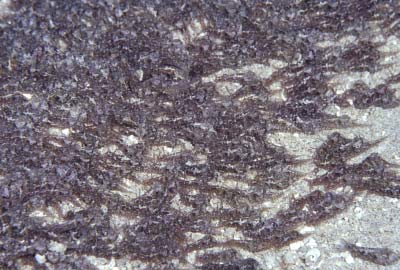
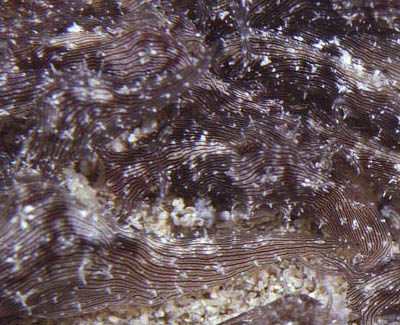
Dear Bill,
You question whether Sea Hares swarm. I can't think of any other term to describe what the Stylocheilus striata in the two attached photos are doing. This phenomenon is not uncommon at one location where I dive from time to time off the leeward side of Oahu, where virtual rivers of these slugs -- sometimes 30 ft. long -- travel head-to-tail along silty sand at depths of about 50 ft. The same phenomenon was mentioned years ago in the newsletter Hawaiian Shell News, so I know I'm not the only one to have noticed. However, the slugs look much like clumps and windrows of decaying algae and most divers probably don't recognize them for what they are.
John
hoover@hml.org
Hoover, J., 2002 (Apr 7) Swarming in Stylocheilus striata. [Message in] Sea Slug Forum. Australian Museum, Sydney. Available from http://www.seaslugforum.net/find/6681Dear John,
Thanks for these photos. I guess it is a matter of semantics. I am aware of Stylocheilus being found in large dense populations, that's why I referred Stephen to Cory Pittman's observations of large numbers of Stylocheilus drifting together in Hawaii.
The question is how or why these animals come to be together in high densities. Are they together as a behavioural phenomenon, such as migrating to a special place - like eels, or been attracted together by pheromones etc, or have they been physically washed together by water movement? Or have they have been together since they settled out of the plankton? To me, the word swarming suggests a behavioural phenomenon and my understanding of the research is that large densities of Sea Hares occur because of heavy larval settlement at a particular locality, and is accentuated by animals being washed together late in life by physical factors - waves, storms, currents - in a phenomenon which can lead to mass mortality. There is no question that they can occur in large numbers as you have illustrated. I guess the distinction I am trying to make is that dense 'crowds' of Sea Hares occur, not as the result of Sea Hare behaviour, but through a conjunction of random events - high larval settlement, good growth of food algae, good weather during growth period etc.
Hope that makes sense,
Best wishes,
Bill Rudman
Swarming behaviour in Aplysia
April 3, 2002
From: Dr. Stephen Hoskins.
Dear Dr.Rudman,
I've been thinking more about swarming in Aplysia and wondered whether there was any evidence for Aplysia secreting pheromone equivalents into the water which chemotactically attract individuals to congregate, and then move together towards the shore driven by tides(like that exhibited by individual slime-mould cells coming together and moving as one, or sperm following a chemical gradient en masse through the cervix).
Dr Stephen Hoskins.
SRH@4TheNet.co.uk
Hoskins, S., 2002 (Apr 3) Swarming behaviour in Aplysia. [Message in] Sea Slug Forum. Australian Museum, Sydney. Available from http://www.seaslugforum.net/find/6651Dear Steven,
The basic question is not what makes them congregate but whether they congregate at all. My understanding of the literature is that there is no evidence that Sea Hares congregate or migrate - except as a chance larval swarm. Although at times it seems that large numbers of adults have 'just' arrived at a certain locality, this appears to be an illusion. Juveniles have very good colour camouflage, and grow very quickly. Unless an observer is meticulously surveying a locality on a regular basis, it is not unusual to not notice a large Aplysia population until they have reached adulthood. Observations can also be complicated by the phenomenon of mass mortality, where large numbers of animals can be seen washing up on beaches to die. These are usually from subtidal populations, usually near the end of their life-cycle being washed ashore because of prevailing weather conditions. Basically a 'swarm' of Sea Hares differs from a swarm of bees. In bees it is a pheromone driven part of their behaviour, in Sea Hares, it is a result of them growing up together in dense populations.
Have a look at the Mass Mortality Page for more discussion on this topic and relevant links.
Bbest wishes,
Bill Rudman
Re: Sea Hares - mass mortality
September 28, 1999
From: Anne DuPont
Dear Bill,
The Sea Hares I described in my message appeared to be almost dead. When I picked up one, it did not try to move, but it did ink me. I will send you via snail mail all the photos I took that day to help you with identification.
Also, here is a response I received from Paul Johnson.
Dear Ms. DuPont,
Thank you for sending me your question - it's always nice to find someone interested in sea hares. By your photo it looks like you found Aplysia dactylomela, a very common species in Florida waters. I did my undergraduate work at the University of Miami and even got over to Captiva a few times. By their size, large numbers, and the time of year, it seems most likely that they were dying of natural causes. Most Aplysia species have an one year life cycle and the Florida A. dactylomela seem to have two population waves per year - one that reproduces in July and August then dies and the other that reproduces in February and March then dies. After laying their egg masses (containing millions of eggs) the dying adults just wash up on the beaches in large numbers. You seem to have been fortunate enough to have observed the end of some successful sea hare lives. Their young should be back in great numbers next year.
Thank you and Best Wishes,
pm
Paul Micah "PM" Johnson
University of Washington, Dept. of Zoology
Kincaid Hall, Box 351800 (RM 204)
Seattle, WA 98195-1800
Hope this helps,
Regards,
Anne Dupont.
adupont@gate.net
DuPont, A., 1999 (Sep 28) Re: Sea Hares - mass mortality. [Message in] Sea Slug Forum. Australian Museum, Sydney. Available from http://www.seaslugforum.net/find/1373Dear Anne,
Thanks for the message and I see that Paul also thinks the deaths were probably a natural phenomenon. I look forward to receiving the photos. Hopefully they will help us identify the species. I must say from your original photos that the animals do not look like Aplysia dactylomela, which is usually characterised by large black rings in its colour pattern. See earlier message on mass mortality of Aplysia dactylomela in Florida, and photo of animal from the Bahamas.
Bill Rudman.
See later message from Anne Dupont for further photos and discussion on its identity - Bill Rudman.
Rudman, W.B., 1999 (Sep 28). Comment on Re: Sea Hares - mass mortality by Anne DuPont. [Message in] Sea Slug Forum. Australian Museum, Sydney. Available from http://www.seaslugforum.net/find/1373Re: Sea Hares - mass mortality
September 10, 1999
From: Wayne Ellis
Hi Bill,
What timing! The September issue of anNEWS (due 14/9/99) contains a piece on a mass stranding in Moreton Bay.
Wayne
glaskin@ozemail.com.au
Ellis, W., 1999 (Sep 10) Re: Sea Hares - mass mortality. [Message in] Sea Slug Forum. Australian Museum, Sydney. Available from http://www.seaslugforum.net/find/1322I'll be interested in reading about it Wayne. If you have any spare photos perhaps I could post one on the Forum (after you of course) for those who are Acrobat-challenged and can't access pdf files.
Bill
Sea Hares - mass mortality
September 9, 1999
From: Anne DuPont
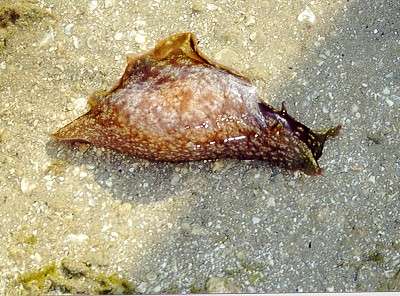
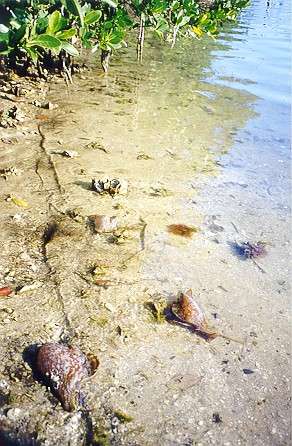
Dear Bill,
Here is a copy of a letter I have sent to P.M. Johnson, who I see in the Forum is a PhD student in zoology at the University of Washington working on defense in sea hares.
This spring, March, I was on a trip on my boat on the west coast of Florida (USA). We were anchored off the Tween Waters Resort on Captivia Island. I was very shocked to see dozens of dead Sea Hares along the shore.
I am sending you a couple of photos, one of a Sea Hare and one shows the environment. I ask a local fisherman and he said that it happened a lot. This was along the shore in front of the marina and I was wondering if gas and diesel in the water would kill them. The ones that were not dead seemed to be dying the the shallow water. I picked up one that seemed to be dying and it inked me.
I sent out several e-mails inquiring about the cause and this is the best reply I received.
Dear Mrs. DuPont,
Very hard to tell what kill the sea hares without being there; I know for a fact that there was a mild case of red tide earlier this year, stronger on Captiva than on Sanibel, but your picture of the environment does not seem to show the unusually dirty shore line that we see during episodes of red tide. If the animals died as a result of congregation during the mating season, you might have witnessed a result of the "mating frenzy" (not so much of a frenzy in sea-hares though). Last but not least, it could be oil in the water; these animals move up and down the bay, and if they hit a locally polluted marina, there you go, although I really cannot say that Tween Waters, or anywhere else in Captiva is "polluted". Thanks for forwarding the message to me,
Jose H. Leal, PhD
Director, The Bailey-Matthews Shell Museum
Editor-in-Chief, The Nautilus
leal@water.net
3075 Sanibel-Captiva Road
P.O. Box 1580
Sanibel, FL 33957
I hope this helps your research.
Cordially,
Anne DuPont
adupont@gate.net
DuPont, A., 1999 (Sep 9) Sea Hares - mass mortality. [Message in] Sea Slug Forum. Australian Museum, Sydney. Available from http://www.seaslugforum.net/find/1305Dear Anne,
Thanks for the photos and information. Although pollution could be involved, I think it more likely that you saw a natural event occurring. I have discussed these cases of 'mass mortality' a number of times in messages scattered throughout the Forum. So I have made a Mass Mortality page where I have put links to most of the relevant messages and discussions. From the many messages on the A. brasiliana page in recent months, it has been a good year in Florida from Sea Hares. There is also a recent report on mass mortality of Aplysia dactylomela in Florida as well.
If population numbers have been high, then when these animals complete their life cycle, death is more noticeable, as large numbers are found dead together.
I am interested in trying to identify which species your photos are of. Did any of the animals show signs of flapping their parapodia and swimming, or were they too far gone to know? I am afraid the scientific literature is not very clear on identifying species of Aplysia from the east coast of the Americas. I have been calling the swimming species Aplysia brasiliana but now have my doubts. Perhaps your animal is true A. brasiliana Rang 1828, which grows to 270mm, and is reported from New Jersey to Brazil.
Or perhaps it is A. cervina Dall & Simpson 1901, which grows to 100mm and is reported from USA to Brazil. Eales (1960) described it as 'dappled light & dark, no evidence of swimming.
Considering how many queries and observations the Forum is getting about Sea Hares from Florida and the Caribbean, it would be useful to have some clarification, and photos of the species. Any help from anyone reading this would be much appreciated.
Bill Rudman.
